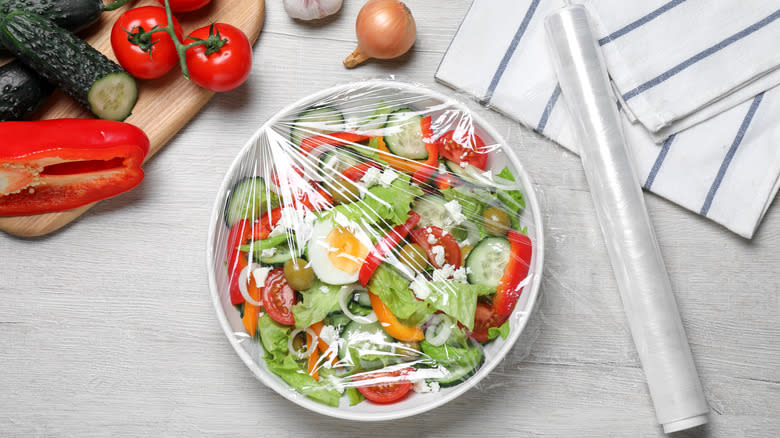How To Finally Master The Art Of Using Pesky Plastic Wrap

Plastic wrap can be both a blessing and a curse. In theory, it can seal and secure any dish, bowl, or tray of leftovers with ease. However, it isn't always this straightforward. You might tear a wonky sheet. Sometimes your hand grazes the dispenser's teeth. Other times the plastic just doesn't properly adhere to a dish. To avoid these annoying ordeals, it's time that you learned the proper way to use pesky plastic wrap once and for all.
Although plastic wrap (also dubbed cling wrap) may not be the most sustainable of options, it is relatively inexpensive and simple enough to use — if you know how to use it. Luckily, the method to effectively cover a dish is just a matter of entirely enveloping it with plastic wrap. After all, since nothing sticks to plastic wrap better than itself, using it to encompass all sides of a plate proves to be the easiest solution.
Whether you're working with heavy-duty food service film or a flimsy run-of-the-mill plastic wrap, the first step is to successfully tear it. We recommend using one hand to pull the plastic and the other to hold the box. Additionally, make sure to pull out double the necessary amount without detaching it. Then, place your plate over top of the wrap, tightly stretching the plastic over it. Turn the dish perpendicular and repeat the process again (even twice), before finally tearing the plastic wrap.
Read more: 11 Cleaning Tips For Keeping Your Oven Spotless
Using Plastic Wrap The Right Way Has Its Benefits

Along with simplifying the act of wrapping dish ware and alleviating stress that goes with it, mastering the art of using plastic wrap has many functional advantages. That said, its greatest strength comes from totally enclosing the serving vessel, so that the risk of spillage is greatly diminished. Food stays contained where it should, and this means you no longer need to worry about how to transport even the creamiest of casseroles or runniest of dips to and from family potlucks. And, that's just the tip of the iceberg.
Given the airtight environment that this method of wrapping provides, food can also be kept fresher for longer. Rather than prematurely compromise quality, wrap a tray twice (or thrice!) to prevent air and moisture from seeping in, slowing oxidation and any consequent spoilage. Naturally, this is an especially great asset if you plan to store foods for an extended period of time in the freezer. Plus, plastic wrap can even stop odors from leaching into leftovers, and vice-versa.
The bottom line is that learning how to properly use plastic wrap is a useful skill. It's for this reason that entirely wrapping a dish in cling film should become your go-to move from here on out.
Read the original article on Tasting Table.

